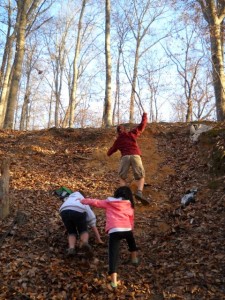Before kids come out to a program at the Prairie Ridge Ecostation, the N.C. Museum of Natural Sciences’ wildlife learning center, Jan Weems asks them to draw a picture of what they think they’ll see.
“They draw pictures of bears and lions and all these really big animals,” says Weems, the center’s senior manager of early childhood programs. At the end of the program, when she asks them to draw a picture of what they actually did see at this 45-acre natural oasis in the heart of Raleigh, she gets sketches of tadpoles, frogs, crickets, ladybugs … .
“The reality is it’s really much more fun to get close to a lady bug,” says Weems, who has been in the business of exposing kids to the outdoors for 30 years.
The reality is also that today more than ever, too many kids like the ones viewing Prairie Ridge as a wild jungle have only a vague notion of what’s going on outside their living room windows.
That’s why in 2006, N.C. Museum of Natural Sciences’ Director of Education Liz Baird deemed it necessary to create Take A Child Outside Week, seven days at the end of September dedicated to introducing our increasingly insulated youth to the great outdoors. Take A Child Outside Week 2013 begins Tuesday and runs through Monday, Sept. 30. At least 82 Take A Child Outside-related programs are scheduled throughout the state. (To find an event close to you, check our calendar, here.)
“The average child spends seven hours a day in front of a screen,” says Baird, “with no logged time outdoors. Obviously, we still need to remind parents to get their children outside.”
Take a Child Outside Week was spurred by Richard Louv’s 2005 bestseller, “Last Child in the Woods: Saving Our Children from Nature-Deficit Disorder,” an account of how, in less than a generation, our kids have gone from being weaned in the wild to garrisoned in the great room.
To anyone who came of age pre-1980, the notion of having to be reminded to go outside and play would have seemed crazy; outside — in a local forest, along a nearby creek, in a neighborhood park — was where kids went to escape. But as Louv notes, a proliferation of electronic options and increasingly protective parents have conspired to keep our kids inside.
Some disturbing numbers:
